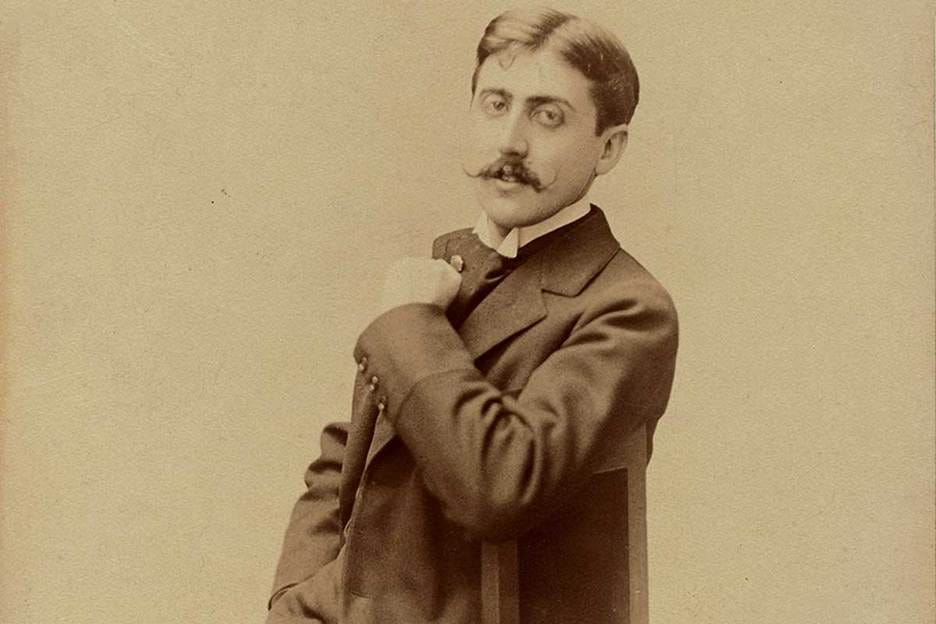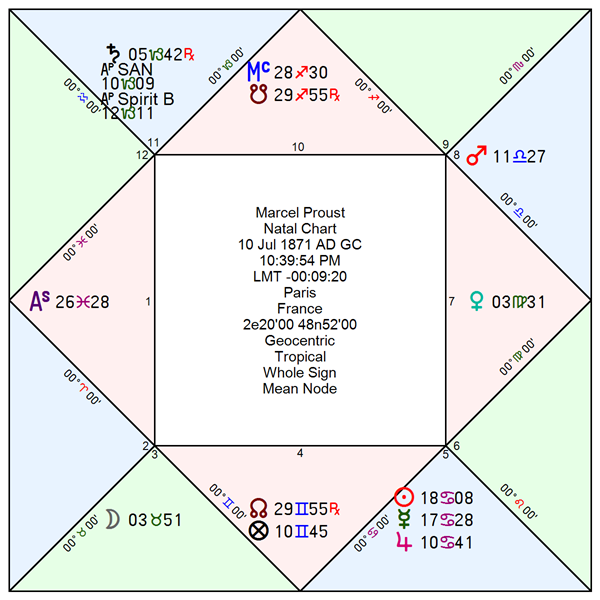The Jupiter-in-Cancer theme continues with Marcel Proust as close to a laboratory-pure specimen as we’ll get: Jupiter, Mercury, and the Sun all in Cancer. When Mercury joins exalted Jupiter here, the mind doesn’t just think; it remembers—feeling-toned, tidal, domestic, intimate. Add the Sun and the creative ego is nourished by private life rather than public conquest. Proust becomes the type case for writers who tap not only personal emotion but the collective storehouse of memory—what later readers will call the “collective unconscious”—and render it with surgical precision. The famous madeleine isn’t a parlor trick; it’s a Cancer engine: sensation → memory → meaning → art.
Under the hood, his Moon’s Configuration sets the trajectory. The Moon carries refinement from Venus and immediately applies to Saturn retrograde in Capricorn, society’s cold gatekeeper opposite Cancer’s hearth: refusals, class snubs, and the demand to build form when affection won’t suffice. Then the Cancer trio takes over—Sun–Mercury forging the writer, Moon to Jupiter widening the psychological lens, Moon to Sun/Mercury sealing fame and method—before the sequence closes where it began: Venus trines Saturn without the Moon. Translation: form over fusion. No permanent partner; a permanent book. If you’re tracking our Jupiter-in-Cancer thread, Proust shows the sign at full power—the memory palace of a nation and an era, made livable sentence by sentence.
Marcel Proust was born on July 10, 1871, in Auteuil (then outside Paris), to Adrien Proust, a prominent epidemiologist, and Jeanne Weil, from a well-to-do Jewish family. A delicate child with severe asthma, he spent long stretches convalescing—an early schooling in observation that later fed his art. He excelled at the Lycée Condorcet, audited philosophy and law in Paris, and, as a one-year volunteer, completed military service (1889–1890) at Orléans. During the Belle Époque he became a fixture of elite salons, cultivating connections that would furnish the social world of his fiction.
Proust’s first book, Les Plaisirs et les Jours (1896), showcased a refined, fin-de-siècle sensibility but little public impact. More formative were his studies and translations of John Ruskin—notably La Bible d’Amiens (1904) and Sésame et les lys (1906)—projects he undertook with his mother’s help; they sharpened his thinking about art, memory, and perception. The Dreyfus Affair made him an early, vocal Dreyfusard, aligning him with republican justice against fashionable anti-Dreyfus circles he otherwise frequented.
Personal losses reshaped his life. Adrien Proust died in 1903; Jeanne in 1905, a blow from which he never fully recovered. In the years that followed, Proust withdrew into largely nocturnal work in a cork-lined bedroom, battling illness while drafting the vast novel that would define him: À la recherche du temps perdu (In Search of Lost Time), begun around 1908–1909. When André Gide and the Nouvelle Revue Française initially rejected the manuscript, Proust financed publication of Du côté de chez Swann (1913) at Grasset. The war interrupted the series, but from 1919 onward the remaining volumes appeared through Gallimard.
The second volume, À l’ombre des jeunes filles en fleurs (1919), won the Prix Goncourt, securing Proust’s reputation. Subsequent installments—Le Côté de Guermantes (1920–21) and Sodome et Gomorrhe (1921–22)—deepened his anatomy of aristocratic decline, sexual jealousy, and social performance under the French Third Republic. Proust died of pneumonia on November 18, 1922, before overseeing the final parts; La Prisonnière (1923), Albertine disparue (also La Fugitive, 1925), and Le Temps retrouvé (1927) were published posthumously from his extensively revised typescripts (the famous “paperoles”).
Proust’s central discovery is involuntary memory—the sudden recovery of time through sensation—iconically staged by the madeleine episode. But his achievement is broader: a new way of narrating consciousness, with long, spiraling sentences that capture how thought actually moves; a sociologist’s eye for class, taste, and snobbery; and a modern meditation on how art transforms life’s contingencies into form. His work sits alongside Joyce, Woolf, and Mann in the modernist canon; Samuel Beckett’s early study of Proust helped secure that standing.
Key works
À la recherche du temps perdu (7 parts, 1913–1927): Swann’s Way; In the Shadow of Young Girls in Flower (Goncourt 1919); The Guermantes Way; Sodom and Gomorrah; The Captive; The Fugitive; Time Regained.
Ruskin translations: La Bible d’Amiens (1904); Sésame et les lys (1906).
Early prose: Les Plaisirs et les Jours (1896).
Legacy
Proust transformed the novel into an instrument for recovering the past and testing the truth of experience. His influence is visible wherever fiction treats memory, desire, and social life not as plot devices but as living processes—an art of time regained.
ADB Rodden Rating AA, BC/BR in hand, 11:30 PM, ASC 23AR05
Proposed Rectification: 10:39:54 PM, ASC 26PI29’06”
Complete biographical chronology and time lord studies available in Excel format as a paid subscriber benefit.
Victor Model factors favoring Jupiter in Cancer
· Sign ruler of Ascendant and Midheaven
· Bound ruler of Lot of Fortune, Lot of Spirit, Prenatal Syzygy
· Sign of exaltation
· Received by sign (Moon) and by bound (Venus)
Physiognomy Model Factors favoring Cancer
· Shape of the face is ovate with white/pasty skin, a “Man in the Moon” look, and a center-part hairstyle, all Cancer traits.
· Sign ruler is Jupiter in Cancer amplified by Mercury and Sun also in Cancer
Moon’s Configuration
Moon in Taurus: separates from trine of Venus
Moon in Taurus: applies to trine of Saturn
Sun conjunct Mercury
Moon in Taurus: applies to trine of Jupiter
Moon in Taurus: applies to trine of Sun
Moon in Taurus: applies to trine of Mercury
Venus trine Saturn
Phase I. Moon separates from Venus (Virgo, 7th House)
Delineation. The Moon departs an exact earth–trine with Venus in Virgo (7th). First imprint: aesthetic perception, social tact, discriminating taste. Relationship becomes a lens; beauty becomes data. The Moon carries from Venus a refined sensorium for faces, manners, and erotic nuance, priming a life that will read society with microscopic attention.
Biographical match. Belle-Époque socialization, maternal cultivation of letters, and the salon circuit supply the Moon’s early “library”—the human textures later rebuilt in Recherche. Love and society provide the raw material the Moon will structure.
Phase II. Saturnian brackets around a Cancer engine
A. Opening bracket — Moon applies to Saturn (Capricorn, 11th House, retrograde)
Delineation. Saturn in Capricorn signifies hierarchy, class order, and institutional gatekeeping; in retrograde, those structures turn as reversal/decay/refusal. In the 11th house, the action plays through circles, patrons, salons, publishers, opinion elites. Mundanely, Capricorn opposite Cancer marks the pole of reactionary/right-wing consolidation; personally, Saturn Rx inclines to withdrawal and cold perseverance. The Moon’s first application, then, predicts rebuffs by the old order, strained alliances, stigmas around sexuality, ideological polarization, and the alchemical conversion of social “No” into form, discipline, and architectural intent.
Biographical match.
· Gatekeeping/refusal. The NRF/Gide rejection and the need to pay Grasset to publish Swann (1913) instantiate Saturn’s closed door; the work proceeds anyway, now under Saturn’s rule of construction.
· Sexual stigma and honor culture. The Lorrain duel (1897) over insinuations about Proust’s intimacy dramatizes elite censure and the demand to defend reputation—Saturn’s harsh etiquette.
· Ideological polarization. The Dreyfus Affair fractures salons along a right/left axis; Proust’s Dreyfusard stance meets resistance from royalist/clerical milieus—Capricorn’s reactionary pole activated.
· Turning inward. Each “No” pushes the Moon toward method: outlines, dossiers, the eventual cork-lined workshop. Social permission is withheld; craft substitutes for rank.
B. The Cancer career engine (5th House) — Sun conjoins Mercury; then Moon → Jupiter → Sun → Mercury
Delineation. Inside the Saturnian brackets sits a compact stellium in Cancer (5th)—the domestic/private memory that fuels creative production. The order matters:
· Sun conjunct Mercury (CN, 5th). The forge of craft: conscious focus binds to articulation. Technique is established before expansion.
· Moon → Jupiter (CN, 5th) [sextile]. Breadth and interpretation: the lunar archive opens into psychological amplitude and moral/social inquiry.
· Moon → Sun (CN, 5th) [sextile]. Illumination and visibility: the work attains public recognition; the native steps into light.
· Moon → Mercury (CN, 5th) [sextile]. Sustained intellection: revision, analysis, and the long sentence carried to completion.
Biographical match.
· Forge (Sun–Mercury). The years 1908–1909 mark the decisive turn: nocturnal labor, voice, and method are hardened first—exactly as the Sun–Mercury order predicts.
· Expansion (Moon→Jupiter). The drafting years to 1913 widen into the theater of jealousy, class, memory, belief, and the social anatomy of the Guermantes/Verdurin worlds.
· Recognition (Moon→Sun). 1919 Goncourt for Jeunes filles is the solar seal: illumination bestowed by the public.
· Continuation (Moon→Mercury). 1920–1922: relentless refinement, paperoles, revisions—the writer’s craft as a daily rite until illness closes the workshop.
C. Closing bracket — Venus applies to Saturn
Delineation. The sequence resolves as Venus perfects a trine to Saturn without lunar mediation. What began as Moon separating from Venus and applying to Saturn returns in a stricter key: beauty/love (Venus) accepts time/form (Saturn) on Saturn’s terms. In doctrine, this is form over fusion—desire stabilized as structure, not as partnership. Thematically it reprises the class code, but now emotion yields to architecture. Add the personal Saturn Rx signature of isolation: love is contained, privacy becomes practice, and the lasting bond is the Work itself.
Biographical match.
· Form, not marriage. Proust never achieves a permanent romantic union; attachments remain unstable, surveilled, or transformed into pages. The Albertine cycle literalizes custodianship over fusion.
· Class and acceptance—at a price. The aristocratic world is finally mastered in representation, not in belonging; society is recast as structure on paper.
· Isolation consummated. The final years bring intense seclusion—the cork-lined room, nocturnal regimen, guarded health. Venus resolves not in domestic fusion but in Saturnian permanence: À la recherche du temps perdu as the durable consort time cannot unmake.
Interpretive Summary
Proust’s Moon carries Venus in Virgo (7th) into Saturn in Capricorn (R, 11th) and, in doing so, sets the life’s argument: what begins as a trained eye for beauty, manners, and intimacy must pass through society’s hierarchy and refusal. The opening application to Saturn—retrograde and lodged in the house of circles, patrons, and opinion—predicts gatekeeping, ruptured alliances, and stigmas that redirect the native inward. In mundane terms, this is the pole opposite Cancer: reactionary consolidation and class code (the Dreyfus split); in the personal register, withdrawal and discipline. The result is not exile without produce, but craft under pressure: the Moon learns to build.
Inside these Saturnian brackets runs the Cancer engine. With Sun conjunct Mercury in Cancer (5th), technique and voice are forged first; then the Moon’s applications to Jupiter, the Sun, and Mercury widen perception, confer visibility, and sustain the long labor. Here the exalted Jupiter in Cancer supplies amplitude—memory becomes inquiry rather than reminiscence—while Cancer’s private nourishment is transmuted into public art. The career thus proceeds as a coherent lunar sequence: craft → breadth → acclaim → sustained revision.
The sequence closes as Venus perfects a trine to Saturn without the Moon: the same Venus the Moon first left now accepts time’s law directly. In doctrine, this is form over fusion—affection stabilized as structure, not as partnership. Biographically, the world that once withheld permission is mastered in representation rather than in belonging; the personal arc bends toward isolation made method; and the durable union is with the Work. In sum, Proust’s Moon’s Configuration frames a life where society’s No becomes the architect of a book-shaped Yes: beauty disciplined by time, memory built into form.
AI Notice: ChatGPT contributed to this article.
Keep reading with a 7-day free trial
Subscribe to House of Wisdom to keep reading this post and get 7 days of free access to the full post archives.



